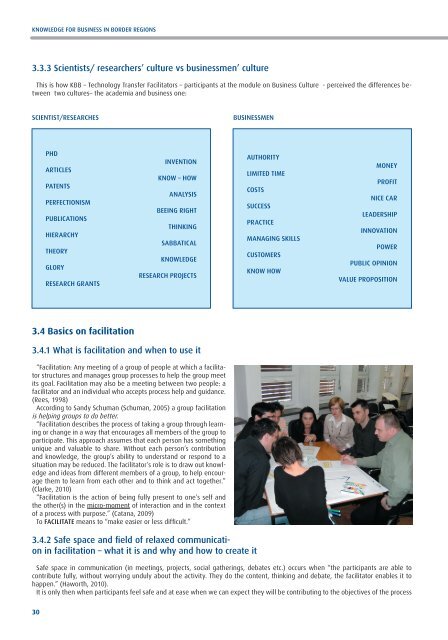TEchNOLOGy TRaNSFER MODEL - Javna agencija
TEchNOLOGy TRaNSFER MODEL - Javna agencija
TEchNOLOGy TRaNSFER MODEL - Javna agencija
Create successful ePaper yourself
Turn your PDF publications into a flip-book with our unique Google optimized e-Paper software.
KNOWLEDGE FOR BUSINESS IN BORDER REGIONS<br />
3.3.3 Scientists/ researchers’ culture vs businessmen’ culture<br />
This is how KBB – Technology Transfer Facilitators – participants at the module on Business Culture - perceived the differences between<br />
two cultures– the academia and business one:<br />
Scientist/Researches<br />
Businessmen<br />
PhD<br />
ARTICLES<br />
PATENTS<br />
PERFECTIONISM<br />
PUBLICATIONS<br />
HIERARCHY<br />
THEORY<br />
GLORY<br />
RESEARCH GRANTS<br />
INVENTION<br />
KNOW – HOW<br />
ANALYSIS<br />
BEEING RIGHT<br />
THINKING<br />
SABBATICAL<br />
KNOWLEDGE<br />
RESEARCH PROJECTS<br />
AUTHORITY<br />
LIMITED TIME<br />
COSTS<br />
SUCCESS<br />
PRACTICE<br />
MANAGING SKILLS<br />
CUSTOMERS<br />
KNOW HOW<br />
MONEY<br />
PROFIT<br />
NICE CAR<br />
LEADERSHIP<br />
INNOVATION<br />
POWER<br />
PUBLIC OPINION<br />
VALUE PROPOSITION<br />
3.4 Basics on facilitation<br />
3.4.1 What is facilitation and when to use it<br />
“Facilitation: Any meeting of a group of people at which a facilitator<br />
structures and manages group processes to help the group meet<br />
its goal. Facilitation may also be a meeting between two people: a<br />
facilitator and an individual who accepts process help and guidance.<br />
(Rees, 1998)<br />
According to Sandy Schuman (Schuman, 2005) a group facilitation<br />
is helping groups to do better.<br />
“Facilitation describes the process of taking a group through learning<br />
or change in a way that encourages all members of the group to<br />
participate. This approach assumes that each person has something<br />
unique and valuable to share. Without each person’s contribution<br />
and knowledge, the group’s ability to understand or respond to a<br />
situation may be reduced. The facilitator’s role is to draw out knowledge<br />
and ideas from different members of a group, to help encourage<br />
them to learn from each other and to think and act together.”<br />
(Clarke, 2010)<br />
“Facilitation is the action of being fully present to one’s self and<br />
the other(s) in the micro-moment of interaction and in the context<br />
of a process with purpose.” (Catana, 2009)<br />
To FACILITATE means to “make easier or less difficult.”<br />
3.4.2 Safe space and field of relaxed communication<br />
in facilitation – what it is and why and how to create it<br />
Safe space in communication (in meetings, projects, social gatherings, debates etc.) occurs when “the participants are able to<br />
contribute fully, without worrying unduly about the activity. They do the content, thinking and debate, the facilitator enables it to<br />
happen.” (Haworth, 2010).<br />
It is only then when participants feel safe and at ease when we can expect they will be contributing to the objectives of the process<br />
30


